
views
- Begin your research synopsis by introducing the question your research will answer and its importance to your field.
- List 2 or 3 specific objectives you hope to achieve and how they will advance your field.
- Discuss your methodology to demonstrate why the study design you chose is appropriate for your research question.
Organizing Your Research Synopsis

Follow the formatting guidelines provided by your instructor. While all research synopses describe the plan for your project, specific formatting guidelines vary among disciplines and even among different programs in the same department. Your instructor or advisor will give you guidelines, so be sure to read and follow them thoroughly. Find out what citation format you’re supposed to use, as well as whether you’re expected to use parenthetical references or footnotes in the body of your synopsis. If you have questions about anything in your guidelines, ask your instructor or advisor to ensure you follow them correctly.
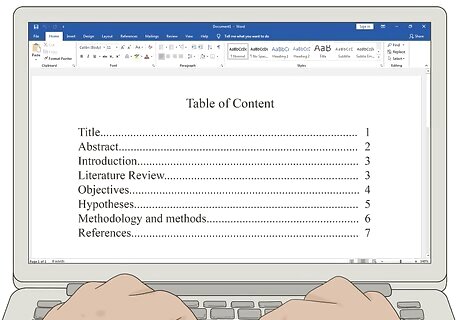
Set up the headings for your sections. A research synopsis typically uses standard headings for the different sections. Your department might have specific guidelines for how to format your headings so they stand out from the rest of the text. A typical synopsis has at least the following sections: Title: the title of your study Abstract: a summary of your research synopsis Introduction: identifies and describes your research question Literature Review: a review of existing relevant research Objectives: goals you hope to accomplish through your study Hypotheses: results you expect to find through your research Methodology and methods: explains the methods you’ll use to complete your study References: a list of any references used in citationsTip: Your synopsis might have additional sections, depending on your discipline and the type of research you're conducting. Talk to your instructor or advisor about which sections are required for your department.
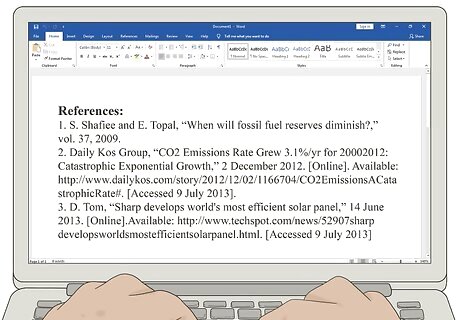
Format your references. Generally, it’s more efficient to format your list of references before you write your synopsis. That way, you don’t have to stop writing to format a reference—you can just plug it in. Keep in mind that you might not end up using all the sources you initially found. After you've finished your synopsis, go back and delete the ones you didn't use.
Writing Your Research Synopsis
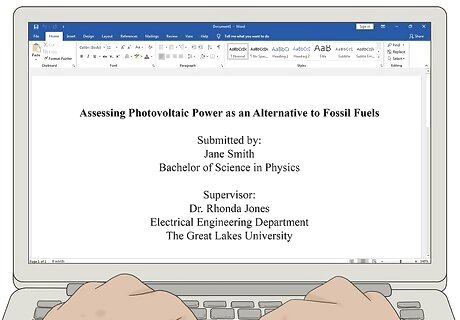
Format your title page following your instructor’s guidelines. In general, the title page of a research synopsis includes the title of the research project, your name, the degree and discipline for which you’re writing the synopsis, and the names of your supervisor, department, institution, and university. Also include any supervisory committee members and their qualifications, designations, and places of work. Your title should be a brief and specific reflection of the main objectives of your study. In general, it should be under 50 words and should avoid unneeded phrases like “an investigation into.” On the other hand, avoid a title that’s too short, as well. For example, a title like “A Study of Urban Heating” is too short and doesn’t provide any insight into the specifics of your research.
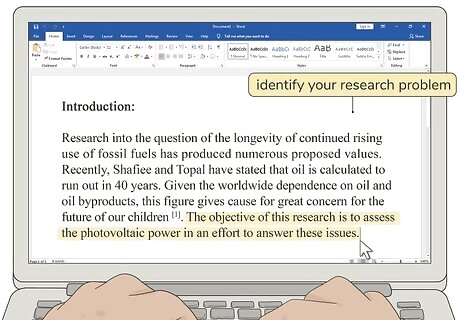
Identify your research problem with the introduction. Describe the problem or question that your research will address and discuss its importance to your field. Start by giving some background to put the problem into context and explaining how you want to approach it. The introduction allows you to explain to your reader exactly why the question you’re trying to answer is vital and how your knowledge and experience make you the best researcher to tackle it. Support most of the statements in your introduction with other studies in the area that support the importance of your question. For example, you might cite a previous study that mentions your problem as an area where further research needs to be done. The length of your introduction will vary depending on the overall length of your synopsis as well as the ultimate length of your eventual paper after you’ve finished your research. Generally, it will cover the first page or two of your synopsis.
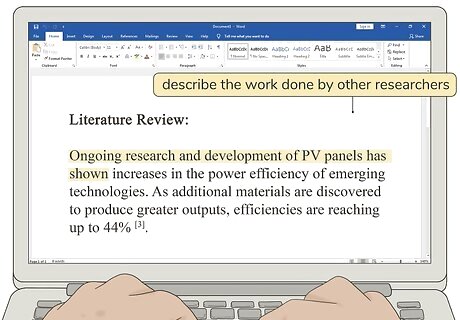
In your literature review, describe the work done by other researchers. Typically, your literature review discusses advancements other researchers have made in the field approaching questions similar to yours. Then, distinguish your research project from those that have already been done to show that you are contributing something new to your field. For example, try finding relevant literature through educational journals or bulletins from organizations like WHO and CDC. Typically, a thorough literature review discusses 8 to 10 previous studies related to your research problem. As with the introduction, the length of your literature review will vary depending on the overall length of your synopsis. Generally, it will be about the same length as your introduction. Try to use the most current research available and avoid sources over 5 years old.
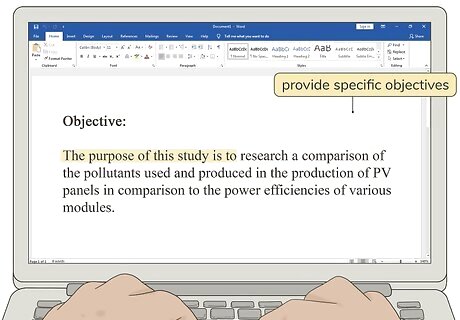
Set forth the goals or objectives for your research project. Include at least one overall objective that describes the contribution your particular project will make to your field. Then, provide 2 or 3 specific objectives that you hope to accomplish through your project. For example, an objective for research on urban heating could be “to compare urban heat modification caused by vegetation of mixed species considering the 5 most common urban trees in an area.” Generally, the overall objective doesn’t relate to solving a specific problem or answering a specific question. Rather, it describes how your particular project will advance your field. For specific objectives, think in terms of action verbs like “quantify” or “compare.” Here, you’re hoping to gain a better understanding of associations between particular variables.
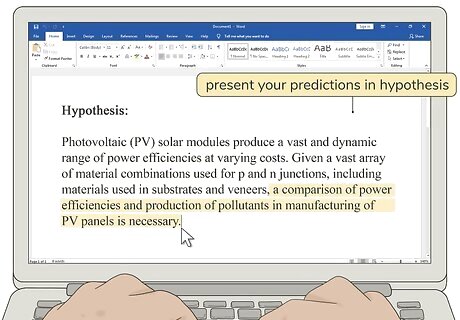
List your hypotheses for your research project. Your hypotheses represent your predictions of what you will find out as a result of your research. Typically, this involves predicting a relationship between two different variables. Your research project will then attempt to quantify that relationship. Specify the sources you used and the reasons you have arrived at your hypotheses. Typically, these will come from prior studies that have shown similar relationships. For example, suppose a prior study showed that children who were home-schooled were less likely to be in fraternities or sororities in college. You might use that study to back up a hypothesis that home-schooled children are more independent and less likely to need strong friendship support networks.
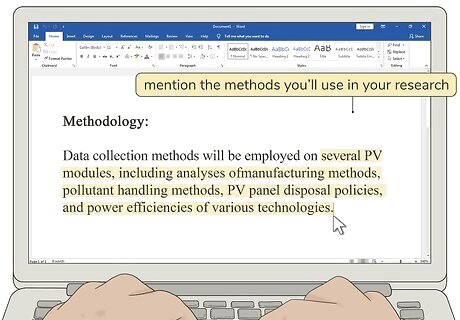
Discuss the methodology and methods you’ll use in your research. The methodology and methods section is the core of your synopsis and lays out exactly how you’re going to answer your research question. Demonstrate to your reader that the study design you’ve chosen is within your reach and appropriate for answering your research question. Expect your methodology to be at least as long as either your introduction or your literature review, if not longer. Include enough detail that your reader can fully understand how you’re going to carry out your study. This section of your synopsis may include information about how you plan to collect and analyze your data, the overall design of your study, and your sampling methods, if necessary. Include information about the study setting, like the facilities and equipment that are available to you to carry out your study. For example, your research work may take place in a hospital, and you may use cluster sampling to gather data.

Complete your abstract last. Since your abstract is a summary of your entire synopsis, it’s typically easier to draft this section of your synopsis after you’ve already finished everything else. That way, you can ensure that your abstract accurately reflects the information provided in your synopsis. Use between 100 and 200 words to give your readers a basic understanding of your research project. Include a clear statement of the problem, the main goals or objectives of your study, the theories or conceptual framework your research relies upon, and the methods you’ll use to reach your goals or objectives.Tip: Jot down a few notes as you draft your other sections that you can compile for your abstract to keep your writing more efficient.
Reviewing and Editing Your Research Synopsis

Take a break before you start editing. You’ll have a hard time finding errors or identifying rough passages if you start editing immediately after you finish writing your first draft. Generally, it’s best if you’re able to put it aside for at least a few days. If you don’t have that kind of time because you’re up against a deadline, at least take a few hours away from your synopsis before you go back to edit it. Do something entirely unrelated to your research, like taking a walk or going to a movie.
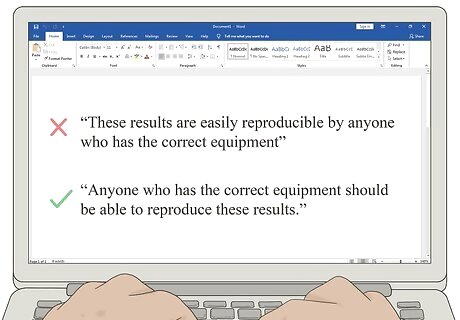
Edit for clarity and concision. When you edit your synopsis, get rid of passive-voice constructions in favor of active voice. Use first-person pronouns to describe clearly what you plan to do with your project. Eliminate sentences that don’t add any new information. Even the longest synopsis is a brief document—make sure every word needs to be there and counts for something. Get rid of jargon and terms of art in your field that could be better explained in plain language. Even though your likely readers are people who are well-versed in your field, providing plain language descriptions shows you know what you’re talking about. Using jargon can seem like you’re trying to sound like you know more than you actually do.Tip: Free apps, such as Grammarly and Hemingway App, can help you identify grammatical errors as well as areas where your writing could be clearer. However, you shouldn't rely solely on apps since they can miss things.
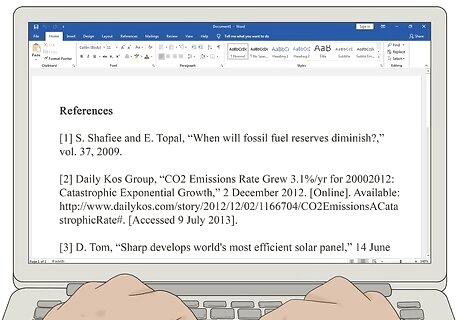
Check the format of your references. Compare your reference list with your synopsis. If you formatted your reference list before you wrote your synopsis, delete any entries for sources that you didn’t use. If you found a new source that wasn’t included in your original reference list, add the new entry. Reference list formatting is very particular. Read your references out loud, with the punctuation and spacing, to pick up on errors you wouldn’t have noticed if you’d just read over them. Compare your format to the one in the stylebook you’re using and make sure all of your entries are correct.
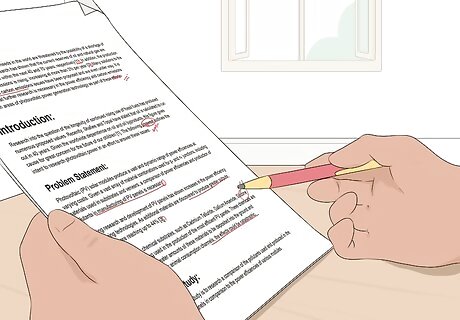
Proofread your synopsis carefully. You’ll typically pick up more errors if you proofread separately from content editing. Once your synopsis reads the way you want it to, check your spelling and punctuation. Try the following tricks to proofread accurately: Read your synopsis backward by starting on the last word and reading each word separately from the last to the first. This helps isolate spelling errors. Reading backward sentence by sentence helps you isolate grammatical errors without being distracted by the content. Print your synopsis and circle every punctuation mark with a red pen. Then, go through them and focus on whether they’re correct. Read your synopsis out loud, including the punctuation, as though you were dictating the synopsis.

Share your paper with classmates and friends for review. Since you wrote your synopsis, it’s easy for you to miss errors others might catch. Classmates or friends offer a fresh pair of eyes and may pick up on errors that you missed. Have at least one person who isn’t familiar with your area of study look over your synopsis. If they can understand your project, you know your writing is clear. If any parts confuse them, then that’s an area where you can improve the clarity of your writing.

Do a second round of editing and proofreading. Before you submit your synopsis, give it another thorough read to make sure it’s accurate and error-free. Reading aloud will help you catch errors you might have missed in previous rounds of editing.


















Comments
0 comment